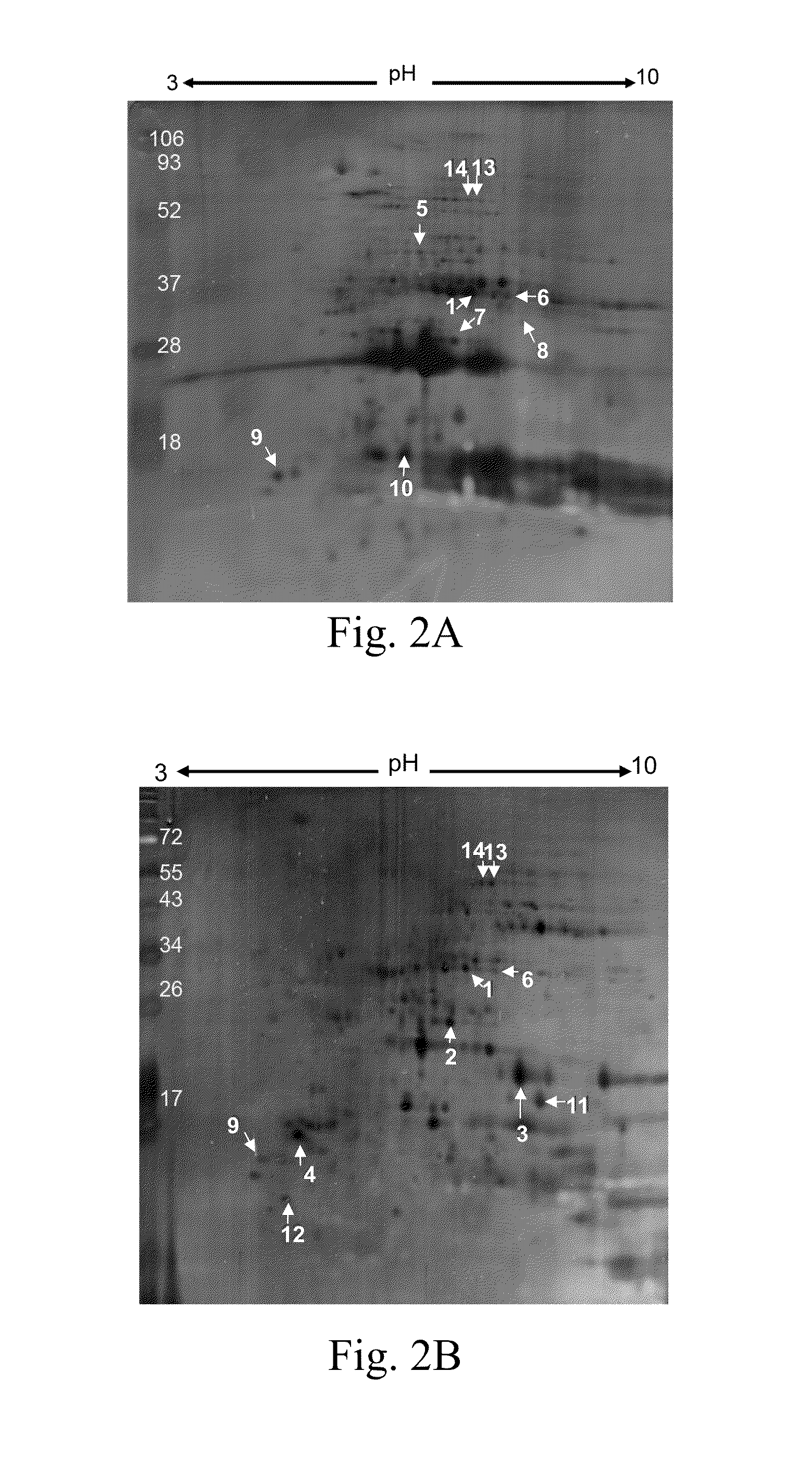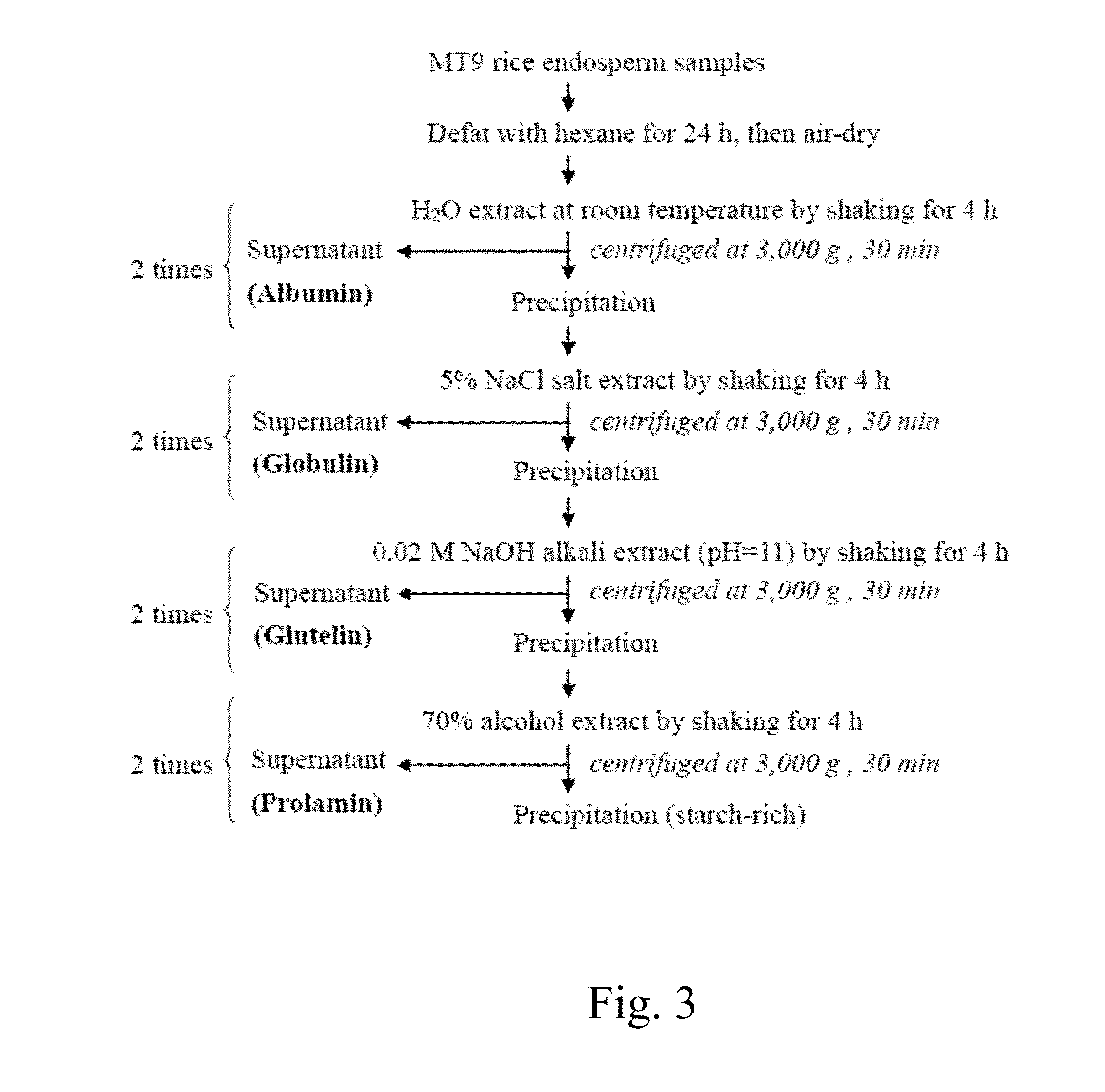Method of treating leukemia using rice prolamin
a technology of rice prolamin and leukemia, which is applied in the field of rice prolamin, can solve the problems of high recurrence rate, unmet medical needs, and severe side effects, and achieve the effect of improving survival rate and reducing side effects
- Summary
- Abstract
- Description
- Claims
- Application Information
AI Technical Summary
Benefits of technology
Problems solved by technology
Method used
Image
Examples
example 1
Effect of Rice Protein Extracts on Leukemia
[0030]To identify which ingredient in the rice could inhibit the growth of leukemia cells, in this example, rice proteins were tested to examine their inhibitory activity on cancer cells.
Preparation of Rice Extracts
[0031]One example of the present invention was carried out using rice (Oryza sativa) grains of cultivars MT 9 (Japonica rice milled Taiwan 9, provided and by the Council of Agriculture, Executive Yuan, Taiwan). To prepare the rice extract, 1.0 g of MT 9 whole rice grain, rice bran and endosperm respectively, was grinded into powder and extracted by stirring with 50 ml of distilled boiled water for 30 min. Total rice extracts, rice bran extracts and endosperm extracts, respectively, were harvested by filtration.
[0032]One example of the present invention used whole grain, rice bran, and rice endosperm extract treated PBMC-CM, to investigate the effect of rice proteins on PBMC activation and their indirect anti-leukemia activity on ...
example 2
Analysis of Biologically Active Substances in Rice Protein
[0037]As shown in Example 1, the ingredients in the rice that possessing anti-leukemia activity were proteins, and inhibition activity of endosperm extract was superior to rice bran extract. Thus, the rice endosperm and rice bran extract of MT 9 were subjected to two dimensional gel electrophoresis and protein profile were compared. The invention further selected those unique protein spots that shown up at different position in two gels and analyzed them by mass spectrum, so that those specific proteins that inhibited leukemia U937 cell could be identified.
[0038]The two dimensional gel electrophoresis equipment used and the experimental protocol in one example of the invention were from Bio-Rad (Hercules, Calif.). Rice bran and endosperm of MT 9 reduced to powder were properly treated and quantified. Then, 50 mM dithiothreitol (DDT), 0.5% of readystrip IEF buffer (Bio-Lyte pH 3-10 and pH5-8 ampholyte Bio-Rad, CA) and rehydrat...
example 3
Assessment of Effect of Rice Storage Proteins on Leukemia
[0042]Although results of example 2 showed that the storage protein glutelin exhibited anti-leukemia U937 activity, rice contained high content of glutelin (for example, content of glutelin in endosperm is up to 80%). Therefore, it was possible that the great amount of glutein could mask the existence of relative scanty amounts of other storage proteins. Thus, storage proteins, including albumin, globulin, prolamin and glutelin were further analyzed for their individual anti-leukemia activity.
Extraction of Four Rice Storage Proteins
[0043]Extraction of four rice storage proteins of the invention was modified from Ju et. al. methods (Z. Y. Ju., N. S. Hettiarachchy, and N. Rath. 2001. Extraction, denaturation and hydrophobic Properties of Rice Flour Proteins. Journal of Food Science, 66(2):229-232.). The flow chart was shown in FIG. 3.
[0044]Rice endosperm (10 g) was grinded into powder with mortar and pestle and then defatted wit...
PUM
| Property | Measurement | Unit |
|---|---|---|
| density | aaaaa | aaaaa |
| concentration | aaaaa | aaaaa |
| time | aaaaa | aaaaa |
Abstract
Description
Claims
Application Information
 Login to View More
Login to View More - R&D
- Intellectual Property
- Life Sciences
- Materials
- Tech Scout
- Unparalleled Data Quality
- Higher Quality Content
- 60% Fewer Hallucinations
Browse by: Latest US Patents, China's latest patents, Technical Efficacy Thesaurus, Application Domain, Technology Topic, Popular Technical Reports.
© 2025 PatSnap. All rights reserved.Legal|Privacy policy|Modern Slavery Act Transparency Statement|Sitemap|About US| Contact US: help@patsnap.com



